Largest Collection Of Ancient “Cup-Marked” Rocks Ever Found In Scotland
A. Sutherland - AncientPages.com - There are many beautiful cup-marks in Scotland. These very ancient carvings are the key to ancient art of our ancestors.
These strange marks have puzzled both researchers and layman alike for more than a century.
David R. Cowan is an author of a fascinating book " Ley Lines and Earth Energies: A Groundbreaking Exploration of the Earth's Natural Energy and How It Affects Our Health" and an independent researcher and dowser with over 20 years experience.
He has investigated countless cup-marks during his over 30 year long research into the earth energy lines of the British landscape.

A fine display of a series of petroglyphs on base rock at Ormaig, Argyllshire. Photo credits: David R. Cowan' s website
These carvings represent a true mystery. More than one hundred theories regarding the reason behind cup-marks have been proposed and as Cowan says "these include a belief in magic, in the afterlife, use as a tuning device and a plan for Megalithic structures." And as he says, "each of these theories appears to have an element of truth in it."
From time to time, researchers are able to deliver some clues, which might lead to the rediscovery of the reason behind this very ancient and still mysterious art, but cup-marks still remain a mystery.
Not long ago, an amazing ancient collection of 28 carved rocks has been discovered by amateur archeologist Douglas Scott, 64, from Tain. This is the largest known concentration of cup-marked stones so far found in the north of Scotland. The carved rocks, some almost 10 ft across have been found in the Highlands on a remote hill overlooking the Cromarty Firth.
'Cup-marks' are simple, roughly hemispherical depressions of about 2-10 cm diameter and up to 3 cm depth on the surface of many megaliths and on a number of separate 'cup-marked stones'.
Cup-marks often appear in groups which can consist of more than one hundred marks on a single stone.
The carvings are about 5,000 years-old and it is believed that they were part of an important ritual centre where ancient people worshiped the sun and performed rites connected to the underworld.
In an interview with the Scotman, Mr. Scott explains "that the first carved rocks on Swordale Hill - Druim Mor in Gaelic were discovered in 1985 by some farmers. A year later, he and and Bob Gourlay, then the Highland regional archaeologist, scoured Swordale Hill and recorded and photographed another 14 cup-marked rocks on the ridge.
"The mysterious standing stones, burial grounds and stone circles that lace Europe, the British Isles and other areas have intrigued scientists, writers, artists and travellers through the centuries. They pose so many questions: Why do some places feel special? How do ley lines work? How did our ancestors use Earth energy to map their sacred sites and burial grounds?
How do ghosts and poltergeists interact with Earth energy? How can Earth spirals and black spots affect our health? This exploration shows how natural forces affect our behaviour, how they can be used to enhance our health and well being, and ultimately, how they bring us closer to penetrating one of the deepest mysteries being explored. A fascinating and visual book about subtle earth energies and how they affect us and the world around them...." Read more
Mr Gourlay has since died and Mr Scott has completed the task of searching the entire hilltop and has now photographed and recorded 28 carved rocks across the site. He said: "The finding of up to 28 cup-marked rocks on Druim Mor makes this the largest concentration of cup-marked stones so far found in the north of Scotland.
Cup-marked stones are not unique but this is the biggest concentration found in this area and that is quite significant in itself because no-one knew these monuments were up there."
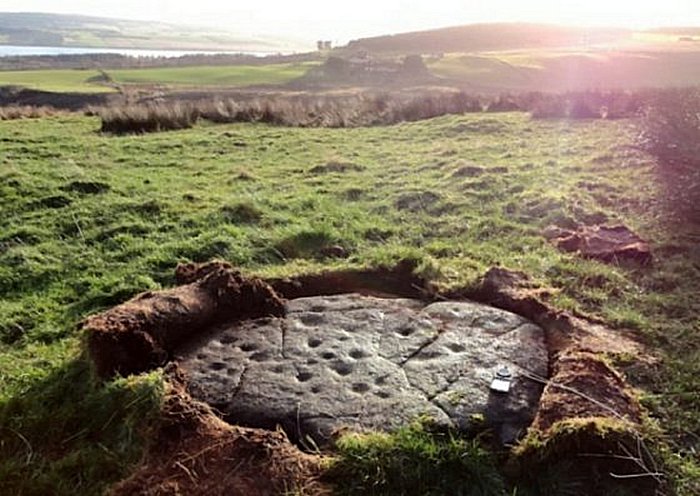
This is one of the 28 up marked stones discovered on Swordale Hill, Evanton. Some of the stones measure 10ft across. Picture: Hemedia
He also said that the carvings on the rocks are anywhere between 4,000 and 5,000 years old and comprise hollows, some surrounded by rings, and grooves which all line up to where the sun rises in midwinter. There is a concentration of them, spread across 150 metres.
There is also a chambered burial cairn and a circular ditch, possible evidence of an ancient henge, on the hill.
"From the ridge, there are wide views across the fertile lands of the Cromarty Firth, the Black Isle and the distant Cairngorms. According to Gaelic folklore, these ancient people believed that the sun was rising and setting in the underworld.
"They would carve these cup marks into the rock at the times when the sun was coming up, out of what they believed was the underworld," Mr Scott said.
A great variety of cup marks can be found throughout Europe and they are usually associated with carvings solar chariots, the sun and boats - the latter believed to carry souls of the dead to the underworld.
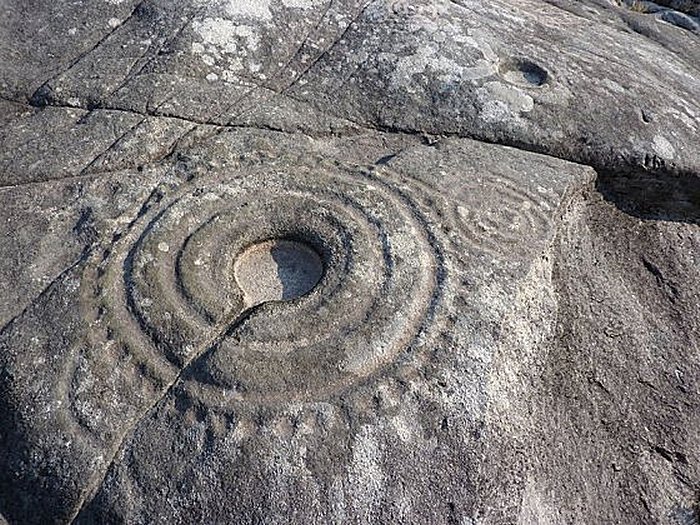
Cup and ring petroglyph at the 'Laxe das Rodas' ('Stone of the Wheels'), Louro, Galicia. Image credit & copyright: Froaringus
See also:
Incredible 5,000-Year-Old Temple Complex In Orkney Could Re-Write History Of Scotland
Similar cup-marked stones have been discovered mostly mainly in Atlantic Europe (Northern England, Scotland,Ireland, Brittany, Portugal and, North West Spain and Mediterranean Europe (North West Italy, Thessalia Central Greece, Switzerland) although similar forms are also found throughout the world including Mexico, Brazil, Greece, and India where the oldest cup marks so far recorded are to be found in the Paeleolithic cave shelter site of Daraki-Chattan.
Cup-marked stones do generally not appear outside the distribution areas of megaliths, but when they appear on graves or stones nearby might have been signifiers of larger cosmological interrelations between monuments, living people, the landscape, the gods and the ancestors.
Written by – A. Sutherland - AncientPages.com Senior Staff Writer
Copyright © AncientPages.com All rights reserved. This material may not be published, broadcast, rewritten or redistributed in whole or part without the express written permission of AncientPages.com
More From Ancient Pages
-
 Secrets Of The Egyptian Ankh Cross And Its Energy Properties Revealed
Ancient Symbols | Feb 13, 2020
Secrets Of The Egyptian Ankh Cross And Its Energy Properties Revealed
Ancient Symbols | Feb 13, 2020 -
 Great Living Chola Temples: Outstanding Workmanship Of Chola Dynasty Builders Of South India
Civilizations | May 31, 2024
Great Living Chola Temples: Outstanding Workmanship Of Chola Dynasty Builders Of South India
Civilizations | May 31, 2024 -
 World’s Oldest Chess Piece Discovered At Humayma In Jordan?
Archaeology | Nov 26, 2019
World’s Oldest Chess Piece Discovered At Humayma In Jordan?
Archaeology | Nov 26, 2019 -
 First Rare Evidence Of Biblical Purple From The Time Of King David And King Solomon
Archaeology | Jan 30, 2021
First Rare Evidence Of Biblical Purple From The Time Of King David And King Solomon
Archaeology | Jan 30, 2021 -
 Forgotten Ancient Kingdom Of Tuwana Is Hidden Among Ruins In Cappadocia
Civilizations | Mar 12, 2016
Forgotten Ancient Kingdom Of Tuwana Is Hidden Among Ruins In Cappadocia
Civilizations | Mar 12, 2016 -
 On This Day In History: Mary Queen Of Scots Born – On December 8, 1542
News | Dec 8, 2016
On This Day In History: Mary Queen Of Scots Born – On December 8, 1542
News | Dec 8, 2016 -
 Mystery Of Sacred Groves Of Oshogbo And Its Remarkable Ancient Figures
Featured Stories | Nov 25, 2023
Mystery Of Sacred Groves Of Oshogbo And Its Remarkable Ancient Figures
Featured Stories | Nov 25, 2023 -
 Archaeologists Have A Lot Of Dates Wrong For North American Indigenous History
Archaeology | May 4, 2020
Archaeologists Have A Lot Of Dates Wrong For North American Indigenous History
Archaeology | May 4, 2020 -
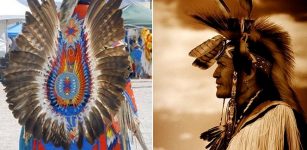 What Was The Symbolism Behind Native American Feathers?
Ancient History Facts | Apr 21, 2017
What Was The Symbolism Behind Native American Feathers?
Ancient History Facts | Apr 21, 2017 -
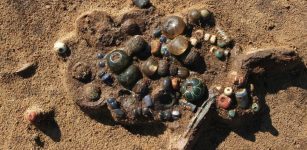 40 Elite Graves Of Men, Women And Children Unearthed On Danish Island Of Bornholm
Archaeology | Feb 3, 2017
40 Elite Graves Of Men, Women And Children Unearthed On Danish Island Of Bornholm
Archaeology | Feb 3, 2017 -
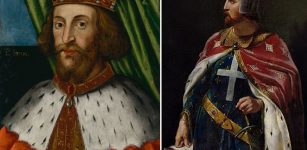 Prince John’s Plot Against King Richard The Lionheart
Featured Stories | Nov 20, 2018
Prince John’s Plot Against King Richard The Lionheart
Featured Stories | Nov 20, 2018 -
 Evidence Europeans Used Slash-And-Burn Methods 9,500 Years Ago For Agriculture Purposes
Archaeology | May 18, 2022
Evidence Europeans Used Slash-And-Burn Methods 9,500 Years Ago For Agriculture Purposes
Archaeology | May 18, 2022 -
 7,000-Year-Old Native American Underwater Burial Site Discovered Off The Coast Of Florida
Archaeology | Mar 3, 2018
7,000-Year-Old Native American Underwater Burial Site Discovered Off The Coast Of Florida
Archaeology | Mar 3, 2018 -
 Mireuksa Pagoda: Largest And One Of The Oldest Of Korean Pagodas
Archaeology | Jan 1, 2016
Mireuksa Pagoda: Largest And One Of The Oldest Of Korean Pagodas
Archaeology | Jan 1, 2016 -
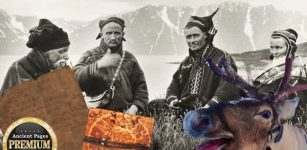 Oldest Known Sami Manuscript Discovered – It’s Undeciphered And Written By An Unknown Author
Linguistic Discoveries | Nov 26, 2024
Oldest Known Sami Manuscript Discovered – It’s Undeciphered And Written By An Unknown Author
Linguistic Discoveries | Nov 26, 2024 -
 6,500-Year-Old Copper Workshop Unearthed In Negev Desert
Archaeology | Oct 6, 2020
6,500-Year-Old Copper Workshop Unearthed In Negev Desert
Archaeology | Oct 6, 2020 -
 Unusual Medieval Picture Stone Found Under House In Klotzow, Germany
Archaeology | Aug 26, 2024
Unusual Medieval Picture Stone Found Under House In Klotzow, Germany
Archaeology | Aug 26, 2024 -
 Ancient Mystery From The Age Of Taurus And The Murdered Astronomer – Overlooked Secret In The North – Part 1
Ancient Mysteries | Oct 30, 2019
Ancient Mystery From The Age Of Taurus And The Murdered Astronomer – Overlooked Secret In The North – Part 1
Ancient Mysteries | Oct 30, 2019 -
 Maize-Based Diet Of Ancient Maya, Vulnerability To Drought And Collapse Of Society
Archaeology | Jul 8, 2019
Maize-Based Diet Of Ancient Maya, Vulnerability To Drought And Collapse Of Society
Archaeology | Jul 8, 2019 -
 Early Bantu Speakers Crossed Through The Dense Central African Rainforest 4,000 Years Ago
Archaeology | Aug 2, 2022
Early Bantu Speakers Crossed Through The Dense Central African Rainforest 4,000 Years Ago
Archaeology | Aug 2, 2022


